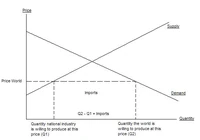International Economy is a pretty straightforward class if you keep up with the work. If you read the book ahead of the class you can just skip since there's no attendance policy but if you get stuck just go for a class or two and ask questions to get a better explanation on whatever concept you don't understand.
First Exam[]
The first part is almost like a history lesson and macroecon rolled into one. Most of the new information is vocabulary so remember the important names and take a look over your macroecon notes. If you still don't understand comparative advantage and the gains from trade you are in the wrong class. Also, if you have Dr. Saarbaum, the exam will be multiple choice.
Things to Remember[]
- Bretton Woods - Conference after WWII that created the IMF and the World Bank.
- World Bank - Bank that lends to developing countries to help with big projects.
- International Monetary Fund (IMF) - Lender of last resort for countries. It was created after the Asian financial crisis.
- General Agreement on Tariffs and Trade (GATT) - After WW II all the nations got together and created an agreement to lower tariffs so countries would trade more. The logic is that countries that trade don't go to war because it costs too much.
- World Trade Organization (WTO) - Created by the Uruguay round of negotiations. It is the organization in charge of negotiating and enforcing trade agreements.
- Most Favored Nation Status (MFN) - Countries with MFN status are charged the same tariffs as the rest of the countries. It is enforced by the WTO under the GATT.
- Public Goods - Public goods are nonexcludable, nonrival, or nondiminishable.
- Regional Trade Agreements - free trade area, customs union, common market, economic union.
Second Exam[]
The second part deals with more detailed theories on trade dealing with tariffs, quotas, subsidies, and regulation. It uses the basic supply and demand graph but it adds a few new lines.

The world as a whole is willing to produce at Price World. National industry at that price is willing to produce Q1 of it. The rest of the supply comes from trade with other countries so Price World is maintained and Q2 is consumed